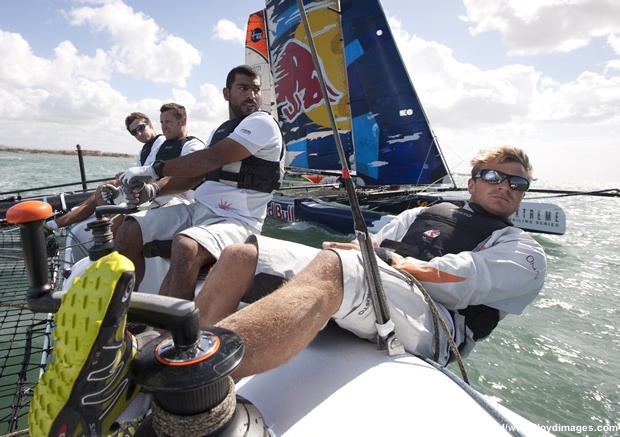
Surprise Oman Sail winner
One would have been hard pressed to have scripted better the conclusion of the 2010 Extreme Sailing Series with two boats jockeying for not only victory in the Almeria event, the last on the circuit this year, but also the overall championship. In the end it was Paul Campbell-James and his The Wave, Muscat team of tactician Alister Richardson, trimmer Nick Hutton and Omani bowman Khamis Al Anbouri, who beat the top French team, Groupe Edmond de Rothschild, led by Tornado and offshore multihull veteran Yann Guichard.
The Wave, Muscat’s overall win was doubly surprising because of the two Oman Sail Extreme 40s, they had gone into the season as effectively the ‘B’ boat to Loick Peyron’s Oman Sail Masirah, which ended the championship in fourth place. At 27, Paul Campbell-James was also the youngest skipper on the circuit this year. “They didn’t expect us to do really well,” says Paul Campbell-James of Oman Sail’s hopes for them this season. “They thought if we did really well we’d get on the podium.”
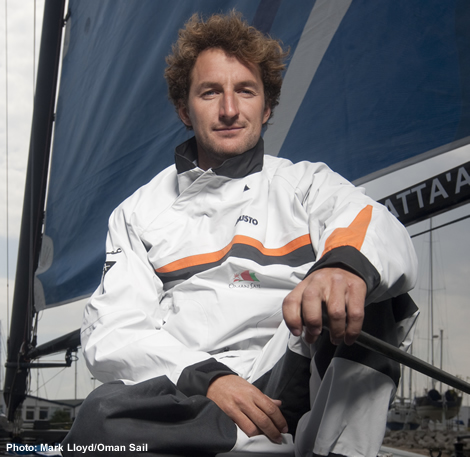
That it should go to the wire, given that the race schedule at Extreme Sailing Series events is monumental – 27 races were held at Almeria alone – was also indicative of the closeness of the competition at the front of the fleet. “We had a pretty good idea going into the last race,” admits Campbell-James. “We had to get a sixth and there were two people OCS so as long as we didn’t capsize or get too big a penalty we were looking good.”
Being level on points with Guichard’s team going into the final day, Campbell-James tactics had been to play it safe, not allowing the wily French Olympic catamaran sailor near them. “We started next to him in the first race (outside of Almeria harbour) but we started off the starboard end in every start and when there’s a wall next to the starboard end, it is about boat handling and he didn’t really have a reply to that. We kept doing that all day, so we didn’t see him.”
Winning the 2010 Extreme Sailing Series - The Wave, Muscat adding victory in Almeria to previous ones this year in Cowes and Trapani, to Groupe Edmond de Rothschild’s wins in Sete and Kiel - Paul Campbell-James said was the highlight of his career so far.
Despite being the youngest team, The Wave, Muscat came with strong credentials. Paul Campbell-James has a strong background as an Olympic 49er sailor and as a match racer. Catamaran sailing is also in the C-J blood - his father David, the well-known PRO, campaigned a Tornado with Reg White’s son Rob and also sailed with White senior on the Formula 40 circuit, the 1980s predecessor to the Extreme Sailing Series.
Paul took over the helm on the Oman Sail Extreme 40 at the beginning of this season after Chris Draper retired to focus on his Olympic 49er campaign. Prior to 2010 Paul admits he had only sailed on Extreme 40s in a few regattas, including in Cowes 2008 when he helmed JPMorgan Asset Management to become one of several Extreme 40s to capsize in the lumpy blustery conditions.
Nick Hutton, a long term Extreme 40 crew, was previously part of Paul C-J’s match racing team, while Alister Richardson aside from being a top 49er sailor, is also a past Extreme 40 helmsman, previously with the circuit-winning Basilica team.
Having a background in another high performance boat, the 49er, helped him, Paul C-J says, because sailing the angles is familiar territory. However there are also other less obvious quirks of these boats. “Ducking is better than tacking,” he says of potential port-starboard incidents. “On big boats if you take a duck you get penalised hard, but in these boats once you have ducked someone, you are pretty much beating the other guy because you gain so much in the duck - you pick up speed - and you come around behind and you can gain a couple of metres. That’s enough that if you do simultaneous tacks then you’ll get them on starboard.”
This is the reason why Extreme 40 starts look so unusual with a disproportionate number of boats starting on port. “And you can fly [the weather hull] high enough that your bow is close to the back of their boat, possibly even over it on occasions (!) We did quite a lot of practice on that.”
A match racing background is also a bonus as with the close boat-on-boat contact, not to mention physical objects like moored ships and harbour walls, Campbell-James says you have to be fully on top of the rules. Another factor is the small size of the race courses that often feature in Extreme Sailing Series regattas that aim to bring the action as close as possible to the public. Racing in Almeria harbour was a fine example: “This is tiny,” said Campbell-James of the race area. “We did some training in Muscat, in a harbour about the same size as this more as a joke, just trying to get used to something super-small. I didn’t realise we’d be coming to somewhere as small and racing with eight boats rather than one or two, and in 25 knots!”
Coming to the Extreme Sailing Series fresh from the Olympic and match racing circuits, Paul C-J has had a first hand opportunity this year to assess where on the scale it falls between a fair, properly competitive event, of the type he is used to, and a high octane sailing spectacle, where the outcome is a lottery, as has been expressed by critics of the short course circuits where spectators ashore can see the whites of the sailors’ eyes.
“I read Iain [Percy]’s article about whether it is too media-driven,” says Paul. “But the top four has been the same four at every regatta, so whether it is media-driven or not that is pretty explanatory. The best guys are coming out on top every time which is the most important thing.
“When it was windy we did some reaching starts - I don’t like that side of it. You have to keep it windward-leewards, otherwise it does become a bit random. Even racing somewhere like this it is hard and it is difficult, but ultimately it is the same for everyone. Tactics are different to Olympic sailing, but if you start well and you get to the windward mark well you are pretty set.”
Maybe the make or break nature of the start is overly important, but C-J points out once again that it is the same for everyone.
The Wave, Muscat has also developed a reputation this year for its part in collisions, although prangs seem reasonably inevitable giventhe nature of the Extreme Sailing Series race format – and, after all, it is all part of the spectacle.
“The ones in Kiel were the worst ones for us,” admits Paul C-J. “They were stupid. The first one we went for a bear away pre-start behind someone, got caught by a gust and couldn’t get the bear away in and ended up having the option of taking out their rudders with our starboard bow or spinning it head to wind and hitting our port bow in the middle of their beam. So we span up and hit the beam, but we felt pretty stupid after that.”
In recent Extreme Sailing Series event, boats responsible for collisions are docked six points (a win equals eight points), although this has yet to be applied in practice.
“The second one in Kiel was a port-starboard at the windward mark where we were crossing and the guy in front of us tacked and the gap suddenly closed up and we didn’t fit through the gap and we got nipped on our back quarter by Red Bull.
“Loick [Peyron] used this boat last year and he took the bow off and the rudders off in one manoeuvre. So our port bow is known as the ‘ice breaker’! But that is all part of the learning and everyone has it.”
Extreme Sailing Series victory for The Wave, Muscat was also particularly sweet given that Omani Khamis Al Anbouri was in the crew. When the Extreme Sailing Series Asia visited Oman earlier this year, Khamis had appeared on a billboard posters displayed throughout Muscat and he is rapidly becoming a national hero. As a nation, Oman lacks sports stars and Khamis is rapidly filling this role. “Their biggest sportsman is a first division goal keeper, so if someone goes out there and is winning world class regattas...” says Paul C-J.
As to the Oman Sail participation in the Extreme Sailing Series during 2011, the plan is once again to field two boats, this time both featuring Omanis in the crew. At this stage it seems likely that both will be on the bow, the main grunty position on the boat, for trimming on the Extreme 40s represents a significant step-up in terms of skill, as Paul C-J explains: “The step to trimming is quite big. In big breeze the kite trimmer is the guy who chooses whether we go down or stay right on the edge and Nick [Hutton] has done a great job of that this year. And main sheet – if the main sheet doesn’t go out at the right time... well, you saw what happened in the MedCup recently...” He refers to Audi All4One piling into the side of Bribon during the Audi MedCup event in Cagliari.
Over the winter Oman Sail crews will be back in Muscat training. Once again this will provide them with a valuable opportunity to get more Omanis out on the team’s two Extreme 40s. However next year it seems likely they will see a fresh influx of competition from some America's Cup teams keen to learn about racing on two hulls.

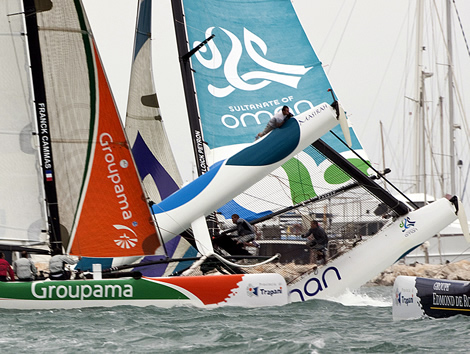
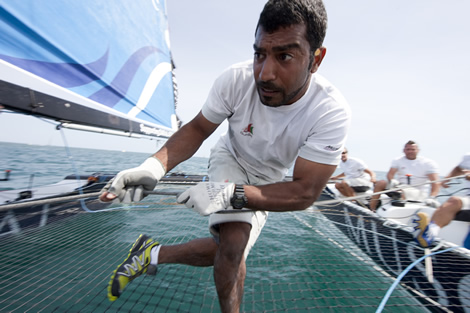
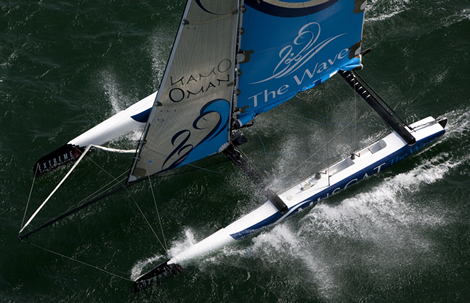
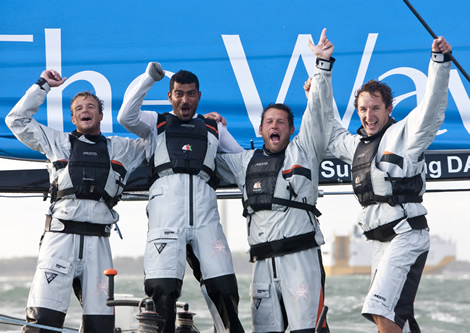
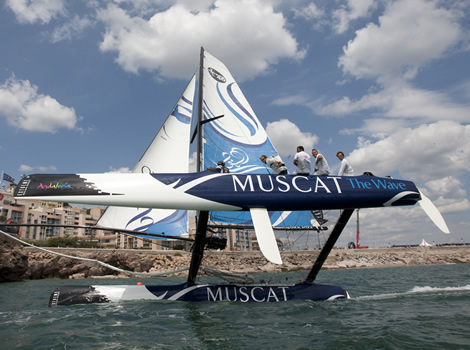









Latest Comments
Add a comment - Members log in